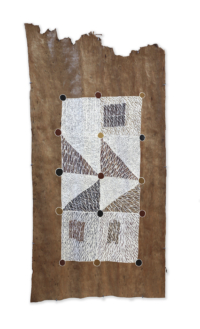Exhibition
Ŋarraku mulkurr milŋurr Ŋarraku rumbal Gunduyŋuru – My mind is the spring My body the Shark – Binygurr Wirrpanda
Where
Outstation Gallery8 Parap Place
Parap, 0820
Darwin, Northern Territory

Art Centres
This exhibition is brought to you by Outstation, in collaboration with the following art centres:
Artists
- Binygurr Wirrpanda
Binygurr’s paternal grandmother Djaparri played a significant role in Australian history. She was a key figure in the High Court case Tuckiar v The King which is a landmark Australian judgment of the High Court that was decided on 8 November 1934, after a two-day hearing on 29–30 October 1934.
She was one of a group of Yolŋu women who had been handcuffed by a police party on Woodah Island in August 1933. The police were searching for suspects in the killings of European and Japanese sailors along the coast of East Arnhem.
One of these suspects was a man called Dhakiyarr who Djaparri called dhuway or husband. Evidence in the trial of Dhakiyarr suggested that a European Constable McColl was left alone with the women as the rest of the party chased after some Yolŋu men.
It was agreed that Djaparri was unchained and that Dhakiyarr subsequently speared McColl to death. His body was found the next day. It was not properly proved why McColl and Djaparri were alone at the time of the spearing. Dhakiyarr was swiftly sentenced to death in the Darwin hearing of the NT Supreme Court.
The subsequent High Court appeal saw him acquitted. He was never seen again after his release and is generally believed to have been murdered by people associated with the police who were aggrieved at the High Court decision.
Dhakiyarr never returned to his home. Djaparri went on to have five children with Dhakiyarr’s brother Djuŋgi. Their first child was Binygurr’s father Nambukul also known as Mulayal (1946-80). Other children of this couple included famous artists Mulkuṉ, Dhukal and Manman.
This group are all members of the small clan, the Dhuḏi Djapu or Bottom Djapu. Their homeland is inland from the shores of Blue Mud Bay. It sits at the point where the Wayawu River disappears under a vast open floodplain which stretches to the mangroves on the horizon. The paperbark ringed chain of billabongs at Dhuruputjpi are the final resting place of the ancestral Shark who was mortally wounded in Buckingham Bay and forced its way through the landscape in pain and anger.
Binygurr is the eldest of the four children of Nambukul and Buwawitj, his mother, whose father was the renowned Gumatj leader and artist Bunuŋgu. Binygurr’s father died when he was ten. It was after this that he moved from Yilpara as part of the homeland movement to establish the buildings at Dhuruputjpi at the direction of senior elder Wakuthi Marawili. He helped to cut the trees for the airstrip and homeland. He lived between here, Gäṉgan and Yilpara before settling at his mother’s homeland of Birany Birany on the shores of Caledon Bay.
Binygurr assumed the role of Chair of Buku-Larrŋgay Mulka Centre in 2022. This acknowledges the respect he is held in. As a senior ceremonial leader he needs to be fully versed in the poetic law of the creation but also needs to convey the authority and sensitivity to lead ceremonies involving hundreds of people over multiple weeks. This balance has always been present in his art. The power of his knowledge of the sacred designs has been expressed through a delicacy of hand and figurative expressiveness which belies that seriousness.
He began to paint for the art centre in 2005 as the ‘Young Guns’ exhibition was being put together.
In the following decade he concentrated upon his ceremonial responsibilities until he moved to his wife’s homeland of Birany Birany on the East coast of the Miwatj region. This coincided with a more prominent ceremonial role and a return to art production. His ironwood sculpture and distinctive renditions of Dhuḏi Djapu law on bark were noticeably individual and high quality.
In 2021 Binygurr began working on discarded signs following the lead that Gunybi Ganambarr provided. This led to his involvement in the ground-breaking sell out show ‘Murrŋiny; stories of metal from the east’ which showed at the Northern Centre for Contemporary art in Darwin in collaboration with Salon Arts Projects. This novel medium also seemed to free up a compositional experimentation. At every step Binygurr has shown himself to be a true artist with a genuinely unique capacity to render his law in new and arresting ways.



























